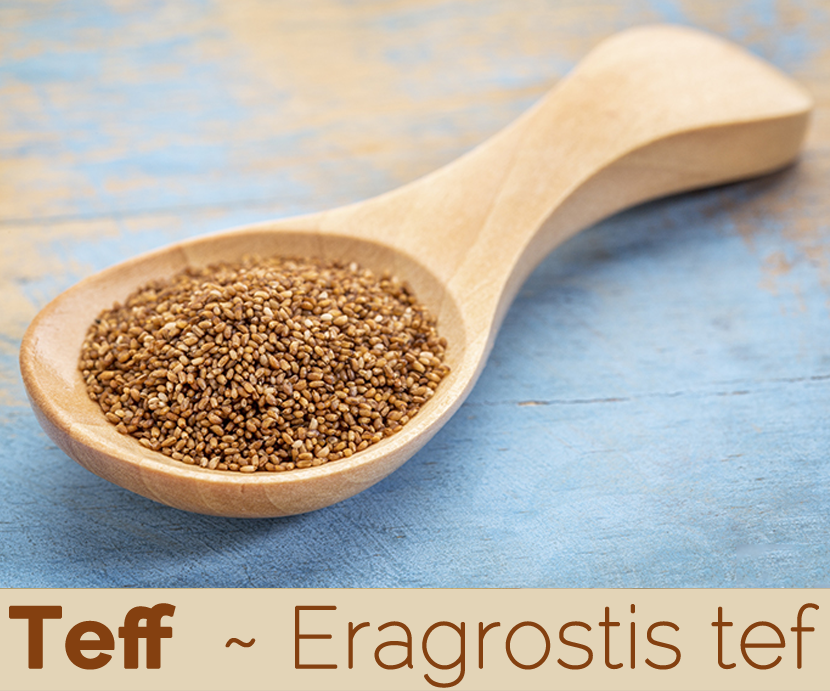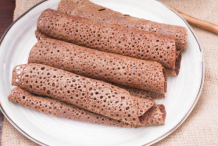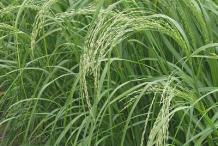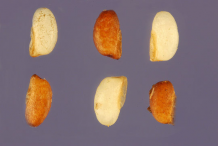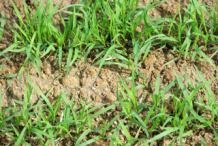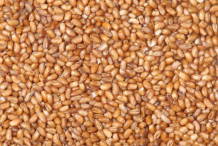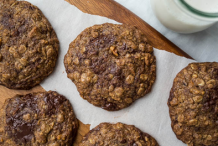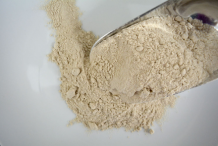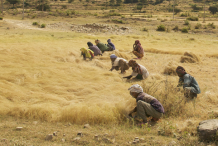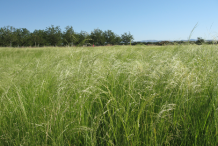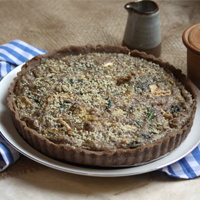| Teff Quick Facts |
| Name: |
Teff |
| Scientific Name: |
Eragrostis tef |
| Origin |
Ethiopia and Eritrea |
| Colors |
White, creamy, yellowish, purple, red or brown colored, depending on the variety |
| Shapes |
Miniature, oval-shaped with size 0.9–1.7 mm (length) and 0.7–1.0 mm (diameter) |
| Taste |
Mild, nutty or warm, earthy taste |
| Calories |
255 Kcal./cup |
| Major nutrients |
Manganese (313.35%)
Iron (64.63%)
Copper (63.33%)
Phosphorus (43.14%)
Carbohydrate (38.50%)
|
| Health benefits |
Healthy Heart, Celiac Support, Increased Circulation, Boosts Digestive Health, Promotes Growth, Diabetes Control, Supports Energy Production, Healthy Bones, Stronger Immune System, Helps Relieve PMS, Lose Weight, Growth and Development, Lower Blood Pressure |
Teff scientifically known as Eragrostis tef is a common cereal crop of Poaceae or Gramioneae family with small grains. The plant is believed to have originated in Ethiopia between 4000 and 1000 BC and can be grown over a very wide range of altitudes (sea level to 3,000 m). Teff is now grown in India, Europe, Australia, Canada and America. Some of the popular common names of the plant are Williams’s love grass, annual bunch grass and taf, tef, teff, Abyssinian love grass, Ethiopian millet and Teff grass. The plant is primarily cultivated cereal crop in Ethiopia with high market price and socio-economic values. There are many teff varieties, with special merits for production in different agro-ecologies. The whitest grain color varieties are considered superior and have high market prices. Word teff originates from Amharic word “teffa” which means “lost”, due to incredible small size of grain (seed has 1/32 parts of inch in diameter). It’s used in a similar way to quinoa, which is another popular health food. It cooks very quickly and can be used to make flour or bread.
Plant Description
Teff is an annual, leafy, tufted grass that grows about 150-200 cm tall. The plant is found growing in degraded forests and banks of backwaters. It is mainly grown on sandy loams, but it can grow on black, heavy clay soils (black cotton soils) provided they are well drained and have sufficient N. Neutral or slightly acidic soils are preferred. The culms are fine, erect, simple or sparsely branched, prone to lodging. The root system is shallow and fibrous. Tef is a leafy species. The plant has hollow, smooth, erect stem that can reach 8 to 47 inches in height. Leaves are glabrous, linear, 25-45 cm long x 0.1-0.5 cm wide. The seed head is a long panicle, 10-65 cm in length, bearing 10-40 slender racemes, which may be either very loose or very compact. Panicles bear 30-1100 spikelets. Fruits are ellipsoid, minute (1-1.5 mm x 0.5-1 mm), yellowish-white to deep brown caryopsis.
Teff is considered as a major food crop in Ethiopia and Eritrea, Africa, where it is mainly processed into different foods and beverages, such as breads, sweet unleavened bread, porridges, pancakes, biscuits, cookies, cakes, stir-fry dishes, casseroles, soups, stews and puddings. The teff kernel is extremely small, perhaps the smallest amongst carbohydrate-rich grains, and it symbolizes an exceptional source of fiber and minerals, especially calcium and iron. Due to its high fiber content and gluten-free status, teff is becoming a popular ingredient in many countries for the production of gluten-free foods, especially bakery products.
Health Benefits of Teff Grain
The health benefits of Teff grains is such that it is a rich source of protein, helps in developing good bones and teeth, free of gluten, helps in reducing pre-menstrual syndrome, treats constipation, regulates blood sugar levels, is low in fat content, helps in providing long lasting energy, is loaded with fiber, helps in reducing weight, controls the signs of early ageing, prevents heart disease. Let’s take a closer look at the fascinating health benefits of teff grain in detail below.
1. Healthy Heart
Teff grain has been shown to be very beneficial for heart health. Low sodium content guarantees that the body doesn’t clog up the arteries too much, and the grain has been shown to effectively decrease blood pressure in research studies. This can reduce your chances of suffering from heart attacks or strokes, and reduce the overall strain on your cardiovascular system. (1)
2. Celiac Support
Many people are suffering from Celiac disease, it will be important to have alternative options to gluten-containing foods. Celiac disease (gluten intolerance) can be quite painful and dangerous for people who suffer from it, which is why gluten-free options like teff grain, mostly since its so nutrient-dense, make for healthy, delicious options for people avoiding gluten.(2)
3. Increased Circulation
Speaking of minerals, the most unusually high mineral content comes in the form of iron. In fact, teff is commonly recommended for patients suffering from anemia. Iron is a key element in our red blood cells, and when there is an iron deficiency in the body, weakness, dizziness, cognitive impairment, muscle cramps, and headaches can often follow (these are symptoms of anemia). If you want to boost your circulation and increase oxygenation to important organ systems and areas of your body, then add some teff grain or injera bread to your diet instantly! (3)
4. Boosts Digestive Health
Teff grain has been used for thousands of years as a laxative, or at least a means to speed up the digestive process. This is likely due to the high content of dietary fiber in the grain, which can bulk up stool, encourage peristaltic motion, and increase the regularity and quality of your bowel movements. Dietary fiber can also balance cholesterol levels in the body by eliminating excess omega-6 fatty acids, in addition to relieving constipation, bloating, cramping, and more serious gastrointestinal issues. (4)
5. Promotes Growth
With eight different amino acids, including a slightly rare one called lysine, teff can deliver substantial support for growth and development. Our bodies need protein to create new cells, repair old ones, and general development throughout our lives. While animal proteins can be helpful, our bodies can more easily break down vegetable proteins into their constituent amino acids, which are why having something like teff in your diet is important for everyone, not just vegetarians and health food fans.(5)
6. Diabetes Control
Teff grain has the ability to help diabetics to manage their condition. By helping to slow the release of insulin into the bloodstream, teff can help diabetics prevent the dangerous spikes and drops that can occur if you aren’t careful. This is partially due to the fiber content of teff grain, but there are more complex chemical pathways also at work in this regard, though research is still in the relatively early stages. (6)
7. Supports Energy Production
Teff grain consist of good amount of copper, which plays important roles throughout our body, including in energy production, growth and repair, enzymatic reactions, nervous system function, and red blood cell creation. Without proper copper levels, many of our body’s systems will begin to fail, so adding a copper boost with teff is never a bad idea. (7)
8. Healthy Bones
Teff consists of a wide range of minerals and nutrients, but in terms of calcium, it is truly impressive. Calcium is an essential mineral for proper bone growth and development, and helps contribute to solid bone mineral density as we age. If you are vulnerable to osteoporosis or have a lack of calcium in your diet, than adding teff can help protect your bone integrity as you age. (8)
9. Stronger Immune System
Although most grains have a wealth of minerals, they aren’t as well known for having a significant level of vitamins, particularly of vitamin C. As you probably know, vitamin C is a crucial part of our immune system, as it encourages the production and activity of white blood cells. However, vitamin C is also a main component in collagen, which is essential for the creation of new cells, blood vessels, organs, and muscle tissue. Together with the high protein content of teff grain, the vitamin C found in this useful dietary staple can have a significant impact on your overall health. (9)
10. Helps Relieve PMS
Premenstrual syndrome is a burden that a lot of women carry for most of their life. Teff has been shown to help with the bloating and cramps that come with it. It also acts as an anti-inflammatory, so therefore it can reduce pain in your muscles.
One of the other components of teff is its high amount of phosphorus, which naturally helps to balance your hormones. It is a wonderful natural remedy for PMS, and helps to control those hormones that can cause such disorder on the body. The increased energy levels that come from the copper also help ease the sluggish feelings and fatigue that comes from PMS. Overall, teff helps to counteract all the negatives that come from PMs and could leave you feeling a lot better.
11. Lose Weight
Perhaps one of the greatest draws of teff is its ability to help you lose weight. Teff is rich in copper, which does a number of things to your body when it’s consumed with food. Mainly, it encourages your body to create the fuel needed, which will boost your energy levels and burn fat more easily.
Not only does the copper help in helping you lose weight, but teff is low in fat, too, so there is no need to worry about your calorie intake. If you add it to something like a healthy soup, then you’d be well on your way to losing any extra weight that you may wish to.
12. Growth and Development
Teff is an excellent food to add to your kids’ diet. The grain consists of eight unique amino acids that contribute to healthy growth and development. Particularly beneficial for kids who don’t want to eat meat, as it has a high amount of protein but not the fats that often accompany a red meat dinner. Teff is rather unique among grain-like foods in that it has lysine, a rare amino acid associated with protein synthesis and antibodies.
13. Lower Blood Pressure
Teff is a low-sodium grain-like food and won’t contribute to blocked arteries, decreasing your risk of heart attack and stroke. Research on the subject has shown that it can actually help you lower your blood pressure. It also helps to balance cholesterol levels by removing excessive Omega-6 fatty acids in your body.
https://www.youtube.com/watch?v=sHRsCyGFcZY
Traditional uses and benefits of Teff
- Teff consists of dietary fiber components that support the body to lose weight and cure obesity.
- It also balances the cholesterol levels within the body to avoid high cholesterol.
- It is used to treat gastrointestinal disorder.
- It is a rich source of amino acids which is helpful for repairing the bones and provides energy to the body.
- It has high amount of fiber which prevents from Indigestion.
- It is capable of avoiding heart diseases and diabetes due to its fiber element.
- It is a gluten-free grain, thus it is often recommended to the patient suffering from Celiac Diseases.
- Teff is rich in calcium nutrient, a dominant supplement for the development and growth of bone. Therefore, it is favorable to cure Osteoporosis.
- It contains vitamin B nutrient that boosts up the Immune System.
- It has vitamin C content which is beneficial for the growth and repair of body tissues.
- Teff cures anemia.
- It is a low Sodium supplement which reduces the chances of getting heart attacks.
- The Iron content of this herb reduces the risk of poor blood circulation.
- It cures the inflammation within the body.
- It regulates the flow during Heavy Menstrual Bleeding and provides relief.
- It serves as a beneficial remedy for premenstrual syndrome and cramps.
- It is often used to avoid bloating.
- It is laxative in nature, thus, it is used to counter constipation.
Culinary uses
- It is used as a cereal for making bread and as a fermented food.
- ‘Enjera’ is fermented pancake-like bread that is a made from this grain in Ethiopia where it is a staple food.
- Grains can be consumed as breakfast cereals or in the form of porridge.
- Flour is used for the preparation of injera, pancakes, waffles and wraps.
- Teff is used in the manufacture of gluten-free beer.
- The grain is also used to make local alcoholic drinks, called tela and katikala.
- Tef grain, owing to its high mineral content, has started to be used in mixtures with soybean, chickpea and other grains in the baby food industry.
Recipe
Teff and peanut butter cookies

Ingredients
Directions
- Preheat the oven to 180°C and line a baking tray with baking paper.
- In a large bowl combine all the ingredients with ½ cup of hot water.
- Shape the mixture into walnut-sized balls, then flatten them gently with a fork.
- Top each flattened cookie with a whole pecan.
- Bake for 15 minutes, then cool slightly and serve.
Banana Bread with Chocolate and Teff Flour
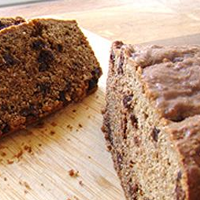
Ingredients
- 1 cup sugar
- 1/4 cup water
- 1 cup teff flour
- 1/2 teaspoon salt
- 1 cup mashed ripe banana
- 1/2 cup whole-wheat flour
- 1 large egg, lightly beaten
- 1/2 teaspoon of baking powder
- 1/2 teaspoon of baking soda
- 1/2 teaspoon ground cinnamon
- 1/2 teaspoon vanilla extract
- 1/2 cup general-purpose flour
- 5 tablespoons butter, softened
- 1 cup semi-sweet chocolate chips
Directions
- Preheat oven to 350 degrees F (175 degrees C). Mix the dry flours, cinnamon, salt, baking powder and baking soda with a wooden spoon.
- Beat the butter and sugar eat using a stand mixer, hand mixer or food processor speed until well blended, about 2-3 minutes. Then add the egg and mix again, and then the water.
- Add the flour mixture into the bowl with the sugar mixture and beat gently at low speed until just blended. Add the chocolate chips and stir through.
- Transfer the cake batter to a 9-inch (20cm) greased loaf pan, lined with baking paper.
- Bake for 50 -65 minutes, or until a skewer inserted in center comes out clean.
- Remove from the oven and cool in the pan for 10 minutes on a wire rack.
- Then carefully remove from pan and cool the cake on a wire rack. Serve just warm.
Artichoke & Teff quiche
Directions
- Start by making the crust- blend the teff flour, almond flour and cornstarch together with a pinch of salt in a large bowl. Add the coconut oil, and slowly add enough cold water to form a firm dough. Let it rest in the fridge for at least 30 minutes, up to 24 hours.
- Roll out the pastry onto a lightly floured surface (use a bit more teff or almond flour for dusting). Using a rolling pin, roll the dough evenly until it is roughly 1 cm thick. Gently drape the dough onto a greased quiche pan, and prick the dough evenly with a fork to allow steam to escape while baking (this is called docking, it prevents the crust from puffing later!) Let the dough rest for another 20 minutes.
- Preheat oven to 185C (370F)
- Once the quiche dough has rested, place a baking paper into the base of the crust, fill with baking beads, and bake for 15 minutes. Let the quiche cool slightly and remove the beads by lifting the paper- be careful, as the beads may still be hot!
- Next, make the filling- cook the mushrooms, garlic and spinach in coconut oil over medium-high heat. Remove from heat and allow to cool before mixing in the rest of the ingredients.
- Fill the crust base with the filling mixture, and return to the oven. Bake for 15-20 minutes longer, until warm and bubbly. Allow to cool for another 5-10 minutes before serving.
Other facts
- Teff is the smallest grain that is less than 1mm in diameter.
- Due to the small size, it got its name from the Amharic word of “teffa,” which means “lost”.
- In just one gram of teff, you’d get about 3,000 grains
- It only takes 36 hours to sprout.
- In other countries like Australia, South Africa, and United States, it is principally used as a forage crop for animal feed.
- Teff can be used as a substitute for eggs, because it contains proteins of the albumin type, just like the egg whites.
- Three thousand grains of teff weigh just one gram (1/28 of an ounce).
- Long-distance runners from Ethiopia consume teff as major source of protein and energy.
- Teff’s straws mixed with mud are used as “mortar” for the building purposes.
- Farmers feed tef straw preferentially to lactating cows and working oxen.
-
Precautions
- Teff is high in fiber and excessive consumption fiber might cause the problem of bloating and gas.
- People with zinc and calcium deficiency are not recommended to consume teff in large amounts.
References:
https://www.itis.gov/servlet/SingleRpt/SingleRpt?search_topic=TSN&search_value=40738#null
https://davesgarden.com/guides/pf/go/98901/
https://npgsweb.ars-grin.gov/gringlobal/taxonomydetail.aspx?id=15320
https://pfaf.org/user/Plant.aspx?LatinName=Eragrostis+tef
https://plants.usda.gov/core/profile?symbol=ERTE
http://www.theplantlist.org/tpl1.1/record/kew-413262
http://ebrary.ifpri.org/cdm/ref/collection/p15738coll2/id/128334
https://en.wikipedia.org/wiki/Eragrostis_tef
Comments
comments


